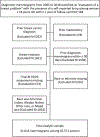Racial and Ethnic Variation in Diagnostic Mammography Performance among Women Reporting a Breast Lump
- PMID: 37440458
- PMCID: PMC10790330
- DOI: 10.1158/1055-9965.EPI-23-0289
Racial and Ethnic Variation in Diagnostic Mammography Performance among Women Reporting a Breast Lump
Abstract
Background: We evaluated diagnostic mammography among women with a breast lump to determine whether performance varied across racial and ethnic groups.
Methods: This study included 51,014 diagnostic mammograms performed between 2005 and 2018 in the Breast Cancer Surveillance Consortium among Asian/Pacific Islander (12%), Black (7%), Hispanic/Latina (6%), and White (75%) women reporting a lump. Breast cancers occurring within 1 year were ascertained from cancer registry linkages. Multivariable regression was used to adjust performance statistic comparisons for breast cancer risk factors, mammogram modality, demographics, additional imaging, and imaging facility.
Results: Cancer detection rates were highest among Asian/Pacific Islander [per 1,000 exams, 84.2 (95% confidence interval (CI): 72.0-98.2)] and Black women [81.4 (95% CI: 69.4-95.2)] and lowest among Hispanic/Latina women [42.9 (95% CI: 34.2-53.6)]. Positive predictive values (PPV) were higher among Black [37.0% (95% CI: 31.2-43.3)] and White [37.0% (95% CI: 30.0-44.6)] women and lowest among Hispanic/Latina women [22.0% (95% CI: 17.2-27.7)]. False-positive results were most common among Asian/Pacific Islander women [per 1,000 exams, 183.9 (95% CI: 126.7-259.2)] and lowest among White women [112.4 (95% CI: 86.1-145.5)]. After adjustment, false-positive and cancer detection rates remained higher for Asian/Pacific Islander and Black women (vs. Hispanic/Latina and White). Adjusted PPV was highest among Asian/Pacific Islander women.
Conclusions: Among women with a lump, Asian/Pacific Islander and Black women were more likely to have cancer detected and more likely to receive a false-positive result compared with White and Hispanic/Latina women.
Impact: Strategies for optimizing diagnostic mammography among women with a lump may vary by racial/ethnic group, but additional factors that influence performance differences need to be identified. See related In the Spotlight, p. 1479.
©2023 American Association for Cancer Research.
Conflict of interest statement
Conflict of Interest Disclosures:
Nyante: No conflicts of interest to disclose.
Abraham: No conflicts of interest to disclose.
Bowles: No conflicts of interest to disclose.
Lee: Personal fees from GRAIL, Inc. for service on data safety monitoring board; textbook royalties from McGraw Hill, Oxford University press, Wolters-Kluwer; personal fees from the American College of Radiology for
Kerlikowske: Non-paid consultant with Grail on the STRIVE study.
Miglioretti: Textbook royalties from Elsevier.
Sprague: No conflicts of interest to disclose.
Henderson: No conflicts of interest to disclose.
Figures

Comment in
-
Enhancing Mammography and Empowering Solutions for Breast Cancer Disparities.Cancer Epidemiol Biomarkers Prev. 2023 Nov 1;32(11):1479-1481. doi: 10.1158/1055-9965.EPI-23-0926. Cancer Epidemiol Biomarkers Prev. 2023. PMID: 37908191
References
-
- Barton MB, Elmore JG, Fletcher SW. Breast symptoms among women enrolled in a health maintenance organization: Frequency, evaluation, and outcome. Ann Intern Med 1999;130:651–7. - PubMed
-
- Barlow WE, Lehman CD, Zheng Y, Ballard-Barbash R, Yankaskas BC, Cutter GR, et al. Performance of diagnostic mammography for women with signs or symptoms of breast cancer. J Natl Cancer Inst 2002;94:1151–9. - PubMed

